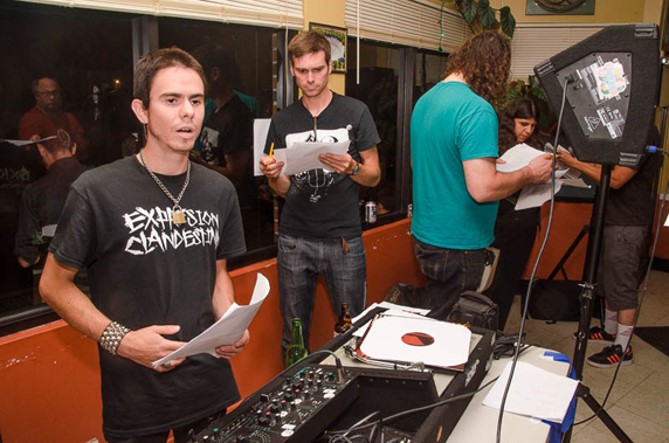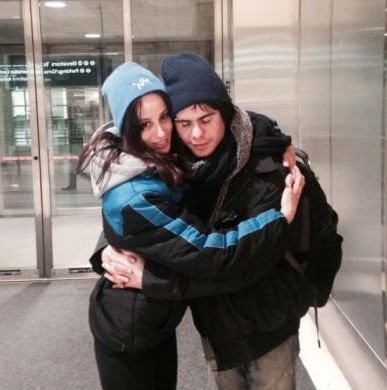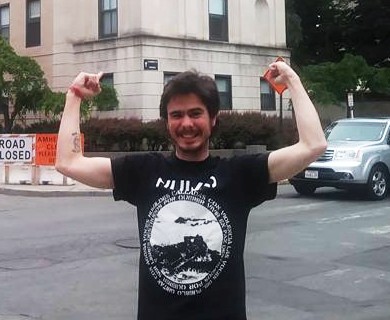Contemporary Korean art and fashion stand out in a new Museum of Fine Arts show
By

by Bruce Sylvester / Troubadour
A few years ago in the wake of the Korean War, South Korea was known as a land of rubble and poverty. But not any more as it’s emerged as an epicenter of pop culture – music, dance, film, fashion. The Museum of Fine Arts is hosting Hallyu! The Korean Wave, whose 250 or so items show the nation’s move to flashy, fun modernity – often reflecting consumer culture’s globalization, but occasionally showing Korea’s forward-looking art incorporating elements of its cultural tradition, like an elaborate recently created suit of armor whose inspiration from bygone centuries may have been meant for show rather than function.
Boston’s Museum of Fine Arts is the first American stop for this show curated by the Victoria and Albert Museum in London. We see photos, videos, fashion items, costumes, and even the recreation of a room in Oscar-winning Korean film Parasite, which, frankly, could have been set in this country just as well as in Korea. It’s a global world now, with K-pop music and dance cresting a wave of popularity. We see the pink suit jacket PSY wore in the video of his hit “Gangnam Style,” the first YouTube video ever to get a billion views.
For interactivity, we can learn K-pop dance steps.
Some of the photography deals with the Korean immigrant experience in America. Another shot features a huge array of pink consumer items. South Korea reportedly leads the world in cosmetics exports.
Maybe it’s realistic for one large exhibit to resemble a very high-end clothing store for well-heeled, adventuresome young people.
Sure, the show’s fun, and, in some ways, it’s social commentary. But mostly it’s fun. HALLYU! THE KOREAN WAVE is at the Museum of Fine Arts through July 28.

Comments closed
Categories: review
Remembering Mateo Williams
By
It is with a heavy heart we inform you that we lost a beloved member of the WMBR family. Mateo Williams passed away on June 19, 2021 due to complications from a rare form of throat cancer. He was 28 years old.
This week, WMBR DJ’s will be airing programs in memory of, and in tribute to Mateo. Please see our Special Events Calendar for the dates and times of these shows honoring Mateo.
Mateo was a DJ on the Late Risers Club from 2012-2016 (and the Cosmic Hearse, the Rude Show, and Better Off Dead). Mateo graduated from MIT in 2015 and was presently completing his PhD at Columbia University, studying Chemical Engineering. Mateo was applying physics, electrochemistry, and materials science to research concerning renewable energy production, storage, and sustainable development. He leaves behind his mother Penelope and his brothers Lucas and Marcos.
Mateo’s unreal amounts of passion and energy ran through everything he touched. He was a scholar, a punk, a musician, an activist, a devoted friend, and loving family member. He excelled in everything he touched, yet would never say no to a good party or a chance to be up to no good. We will miss him greatly.
A Gofundme has been set up to help his family with funeral expenses.

Categories: DJ's
Some downtime anticipated as we move to a new antenna site
By
At this time, the WMBR community should be aware of a project we have been undertaking for the past few years: the relocation of our FM broadcast antenna on MIT’s campus.
WMBR has been a part of MIT since its early days as WMIT, then WTBS: we have always broadcasted from a location on campus. For the past 50 years, that location has been the Eastgate graduate student residence, MIT Building E55. As one of the tallest buildings at MIT, E55 was the perfect home to our 60’ tower atop the elevator machine room on the roof. As we have updated our transmission equipment and increased our radiated power, E55 has continued to serve us well. And in March of last year, we outfitted our transmitter room there with the necessary devices to broadcast fully remotely, 24/7.
But in early 2016, MIT’s ambitious plans to rebuild its properties in Kendall Square were released for public approval, including the removal of E55 to make way for a lower-profile new building. Also in the plans was the construction of a new high-rise, Site 4, which would replace E55 as (among other things) housing for married graduate students. WMBR immediately engaged with MIT leadership to ensure this building would also be the new home for WMBR’s antenna. MIT agreed, as the move was fitting, and the new building would be even taller than E55, allowing us to maintain our antenna height and ability to cover the expansive territory around greater Boston that we do today.
In the fall of 2016, I joined with a team of advisors on the Technology Broadcasting Corporation to plan our path forward. We engaged FCC consulting engineers to scope the permitting required to move our antenna; we planned on major items such as the new antenna, tower, and transmitter; and we started talking to MIT about how we would best work together to incorporate our structure into the new building.
MIT generously agreed to cover all costs associated with moving our station, and with the support we’ve gotten from listeners like you in our annual fundraisers, we were able to plan for upgrades too, taking the opportunity to purchase new equipment that will last us for years to come. I worked with the MIT project team to plan our tower and equipment room facilities into the building, so that what we needed was built right in. And last fall, after completing a skyscraper in the middle of the COVID-19 pandemic, the building opened for residents, and I began to build out our new transmitter and antenna setup with the (mostly remote) support of the WMBR tech team.
In June, E55 will start to be disassembled to make way for the new development in the next phase of the Kendall Square Initiative. We are wrapping up our installation in the new Site 4 building and will make a mad dash to take the last of our equipment out of E55 before the building is decommissioned. In the intervening weeks, testing of the new site will cause some disruption in our broadcast, which will affect our stream as well.
We are planning to cut over from the old site to the new site on Saturday, May 22. That date may shift depending on progress and availability, but when the cutover occurs, we’ll be off the air for some hours. We hope to be able to make any missed shows available on our archives. And prior to that date, we will be taking our old site off the air to test the new site. During those test times, you’ll hear a transition to static, then periods of silence as we test the new transmitter (which will be broadcasting 88.1 megahertz of silence!), then a return to the scheduled programming.
And, once we do cut over and are broadcasting from the new site, there may be unexpected downtime – because no project is 100% perfect the first time around, and we may need to fix a few things. Hopefully, this downtime will be much less than a day. It’s also worth mentioning that we designed our new antenna’s pattern to nearly match our existing one – so that if you can tune in to WMBR on FM today, you can probably hear us just as clear after we make the switch.
For a short period after we cut over – probably a couple weeks – we will have to reduce our transmitter power to 50% to comply with FCC regulations until our license is updated. If you are further from Kendall Square, you might not be able to tune in during that time. You can always listen to our stream, and please know that this condition is temporary.
We appreciate your patience as we undergo this transition. It is because of your support that we can thrive in our new home at MIT – and it’s because of the supportive WMBR community that we know independent, community-driven, FM radio is an essential part of Cambridge and greater Boston!
Comments closed
Categories: Tech
Keeping college radio alive in a crisis
By
As an MIT student club, WMBR is as much a part of MIT as we are a part of the greater Boston independent radio community. About half of our members are MIT students – graduate and undergraduate – and we rely on MIT for our studio space and transmitter facilities. We’re also an all-volunteer station, with no paid staff whatsoever, and manually run all of our radio operations for every hour we are on the air; we also maintain everything from CD players to our antenna to our web stream ourselves, relying on shared volunteer experience and commitment.
On Tuesday, March 10, 2020, MIT’s administration announced to its community that undergraduate students would have to leave campus to “de-densify” dormitory living space to slow the spread of COVID-19. We immediately began to plan for how students could produce and run their radio shows from afar, and if we would be able to ask our non-student members to contribute even more than usual to put those shows on the air. Newly elected General Manager Allison Hamilos, along with former General Managers Hector Iglesias and Caitlin Fischer, Station Manager Erik Morrison, and myself discussed how to respond.
Just as we had formed plans and reached out to our student community, on Friday, March 13, MIT informed us that they would close all non-essential buildings starting the following Monday. The Walker Memorial building, housing our studios, was on this list. We were shocked at this development, but trusted that MIT’s leadership was taking the right steps to protect its community. Just a week earlier, we had already put measures in place to more regularly clean our studios and ban visitors; we were about to limit the number of staff in our studios to fewer than 4 at a time and discourage use of our physical record library. At the time of writing, it’s clear these measures wouldn’t have been enough, but at that time, they seemed drastic. Even still, we could tell that things would continue to change quickly and would not return to normal for some time.
Our last broadcast from our studio was Subject to Change, on Sunday afternoon, March 15. As the station’s Technical Director, I had two days to gather everything from our studios that would be needed to run our station without the benefit of actually being in that studio space. I was still able to access the Eastgate graduate family housing building that hosts our FM transmitter and antenna – only when needed, and with precautions. Since joining WMBR in 2010 as a student, I had seen a raft of technical challenges, but nothing like this. But I was excited to figure out how we could stay on the air.
The challenge was operational as well as technical. WMBR’s fundamental method of operation has changed little from when vacuum-tube FM transmitters were ubiquitous and the only computer on campus took up an entire laboratory. Then as well as now, operating an FM radio station is a serious responsibility, requiring knowledge, record-keeping, and monitoring. Since we have no paid staff, there is no one person – or small set of people – who can continuously oversee our operations. Instead, we split up the responsibility between the DJ’s who are on the air. The DJ for the first show in the morning signs their name in a paper log, uses a remote-control system to turn on our transmitter, plays a recorded legal sign-on message, and starts their show. Every time a new DJ comes on the air, the logs are handed off, signifying that the new DJ now holds the responsibility for legal operation of our station. During a shift, the DJ writes down measurements of our transmitter power and ensures EAS (Emergency Alert System) tests are performed. The methods we use to monitor our transmitter and record what is aired are taught in training sessions and via apprenticeship over weeks – and are dependent on actually being in our studio, pushing buttons and reading displays, and handing something to another person.
Taking our station from this mode of operation to a virtual one would be a leap. Most radio stations – commercial, public, and even many college stations – automate many of their processes to reduce the likelihood of mistakes and the number of paid staff. Having operations automated might allow us to easily switch to remote operation. But that automation is a big change from how we operate, and requires specialized training – and takes away some liberties that we value (such as when to air an EAS test, and the art of a well-crafted segue from one song to the next). Furthermore, while established stations may have a handful of hosts that could each be set up with their own remote studios, and a full-time engineer to coordinate handoffs from one to the other, we have dozens of DJ’s who all needed to be isolated in their homes, with handoffs every hour or two.
Thus, we had two challenges we needed to solve before resuming operations: running our transmitter legally and remotely, and providing radio content from the homes of our DJ’s.
For the first, technical challenge, I gathered equipment that would allow us to continue to control our transmitter remotely. I’d been looking to upgrade our remote-control system anyway to a newer version that would function over the Internet (our old system was a point-to-point analog telephone connection that only provided control points in our studios). So I finished work to connect our transmitter facility’s network directly to our station’s private network, and configured the equipment to interface with our existing transmitter – to remotely turn it on and off, take measurements of its operation, and automatically shut it down if the power deviated from our FCC licensed parameters, or other issues occurred (such as excessive heat in the transmitter room, a water leak from the roof, or a breach in our pressurized antenna transmission line). I and other technical staff could also be notified right away of these issues, by email and text.
While FCC regulations used to require an actual person to continually monitor transmitter conditions, the law changed years ago with the advent of automatic monitoring equipment to allow automated operation, and thus we could legally configure and run our monitoring system to operate our station 24 hours a day without constant supervision. Furthermore, I set up our EAS equipment to automatically send out Required Weekly Tests on a random schedule as required by law – those are the short beeps – as well as relay Required Monthly Tests, which are the spoken messages surrounded by beeps. We’d previously required intervention from the DJ to do both, to allow the noisy audio messages to fit nicely between songs rather than interrupting the flow of a show.
In the two weeks after we shut down our studio, I worked on setting up the devices in my apartment, preparing the equipment for a single follow-up visit to our transmitter facility to get everything running, so as to minimize contact with the graduate community still living in Eastgate. I also set up one of our computers to play back audio to our transmitter, and to be remotely controlled as well. Meanwhile, our webmaster, Ted Young, set up a continuous stream on our website of our archives from Fall 2019 so that our listeners could “tune in” while we were preparing our transmitter to resume operation, and he set up our station’s network to allow the secure, remote connections from our engineers to our transmitter equipment.
On March 27, I took the equipment to our transmitter room and set it up. The already-crowded equipment rack had to make space for our EAS equipment and the computer that would play our audio on the air, and the wiring within the rack became even messier than it had been before (the urgency of the situation took priority over my usual insistence on neatness). I was unsure whether the theoretical work I had done in configuring our transmitter control system would work – after all, any controls system is highly dependent on the dynamics of the plant. Fortunately, prior to (literally) airing any issues, I was able to disconnect our transmitter from our antenna and connect its output to a “dummy load”, a device that allows the transmitter to function at full power but without actually radiating any FM, so that I could tool away without disturbing anyone who happened (for whatever reason) to be tuned to 88.1. I had to make adjustments to the response time of the control unit, and correct a mistake I’d made in setup, as well as wrangle with some device registration issues with our audio computer – showing how quickly I could move from comfort in the analog domain to discomfort in the digital domain, but fortunately assisted by DJ Teep in the process.
I checked the FM and audio parameters one last time, switched our transmitter’s output to our roof-mounted antenna, and locked up. Theoretically, once we worked out how to legally air the archived stream on FM, we were ready to go.
The second challenge – producing radio shows outside of our familiar, physical studios – was less technical, but much harder to overcome. Many of us learned how to do everything radio at WMBR, and even for the radio veterans among us, a radio show is something that’s done live. We talked to each other and demonstrated our techniques over video chat, and tried to give advice to common questions – what recording software should I use? Is it okay that you hear birds in the background? How do I know if I’m at the right level? But beyond the logistics, it was difficult to get used to the idea of doing everything well before it ever reached the airwaves – it makes things feel premeditated, gives you a chance to go back and correct that you don’t get on live radio, and it disconnects you from our listeners. Since the on-air DJ directly monitors the broadcast, we are used to talking into a microphone and hearing our voice come back to us on the air through our headphones.
Over time, though, it was illuminating to see the ways that we all came up with making radio. Some of us built small radio studios and simply recorded the result; others used software to carefully craft shows with nothing more than a USB microphone. And we had to keep our shows’ air times sacred, being on duty to listen to our own show get played on the air and to send the playlist data so our current song would always be shown on our website and on radios, and of course to be ready to respond to our listeners’ texts.
We gave our DJ’s some time to get familiar with this and to produce enough shows ahead of time that we knew we could air most of our Spring schedule when ready. Meanwhile, we decided to air the archived stream from the fall on our FM broadcast.
On the morning we were set to resume FM operations, I awoke uneasy, remembering that I had forgotten one crucial item before leaving the previous day: turning on breakers that controlled power to the transmitter after I’d turned them off as a safety measure while reconnecting our antenna. Even though powering on an FM transmitter while in the process of connecting it to a load can be damaging – and I did not want to add a damaged transmitter to my to-do list – it was a bit superstitious of me to do this, and those breakers were one of the things that we couldn’t control remotely. Hoping I was wrong, I logged into our control system and hit the ON button. No dice. So I scheduled a follow-up visit to flip two switches on Monday, March 30.
Once that was done, just in time for Monday’s LRC broadcast from 25 weeks prior, I turned on our transmitter remotely and played a sign-on announcement, then switched to our online stream. The coarse static from my radio dissolving into silence, followed by the announcement and music, was a moment that was immensely exciting for me and for which I’d been waiting for weeks.
I was amazed by how much work had to go into so simple a moment – most importantly, the work by so many of us to volunteer ways to get back on the air, to carefully coordinate access to buildings that we had been able to waltz in and out of, to consider the impact of replaying EAS messages on-air and how to synchronize our online stream to resume FM operations while simultaneously feeding our FM broadcast. We had put together quite a collective headache in thinking through everything but it was a welcome diversion, and something that I felt we had all prepared for in one way or another.
Because why go into radio, which some consider a dying medium, if you don’t have some aspiration of being that voice that is there when people need it? Yes, it is so easy to put your thoughts down on the record and serialize them into a podcast or a playlist for others to consume, but much harder to do the same thing collectively as a radio station, 24 hours a day, 7 days a week, for decades, in a form that requires you to travel and be close to others and to sweat about whether you are using the right kind of cable or gender of connector or whether your transistors are healthy and happy and modulating 88.1 million times a second in a manner that will please a government body that doesn’t have the time to think about you, but in a form that can reach out to someone walking or driving through a now-vacant city and hear desolate static emit a gentle “ping” and morph into punk rock before their ears, whether they like it or not, and resume its improbable journey.



